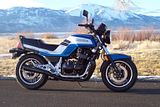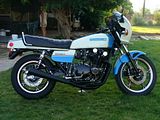I was looking for a simple way to reduce the bounce and found something that work pretty well. Running down the road it was not unusual for the oil pressure needle to bounce +/- 2-4 PSI. This makes it hard to see any changes.
Bruce provides a right angle fitting that converts from the metric thread in the block to thread on the back of the guage. I used this little elbow to create an accumulator.
On the guage side I stuck in some paper, so that when I shoved some JB weld into the other side (actually another automotive two part epoxy) I contained a plug into the part that went into the engine. This creates a small chamber on the guage side. I then drilled out the plug using a small drill. (about 0.070") . This is still large enough to get plenty of dynamic response but now the bounce is less than about +/- 0.5 PSI. In hydraulic terms this is a small accumulator which low pass filters (averages)the hydraulic pressure reducing needle flutter.
Pos
Edit: 4/16/09 After the bike got warm, the oil thinned and the bounce increased ( 3 PSI total spread e.g. 6-9 psi). I went to a Size 60 drill which is about 0.039" which should drop the bounce down to less than 1/3. Have not had a chance to run it to hot to see that improvement though. It moves pretty slow when the oil is cold. Takes about 3 seconds to go from 6 psi to 0 after shutting the motor off (when cold).
FWIW, theoretically this should be an decaying exponential response so it is below 3 psi within about 1 sec.
.png)
 . Like 1/2 the guage range for 0-15 psi.
. Like 1/2 the guage range for 0-15 psi.

 .
.


Comment